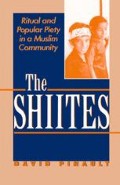Abstract
Before discussing in more detail the Shiite men’s guilds of Hyderabad, it may be worthwhile to analyze briefly one of the principal activities associated with these organizations: the performance of matam, actions of mourning or condolence. Although the term can be used generically to refer to any kind of funeral lamentation, among the Shiites of Hyderabad, as elsewhere in the Shiite world, matam typically designates observances performed during Muharram in honor of Husain and the other martyrs of Karbala. More specifically, the term denotes the striking of oneself—either with the bare hand (as indicated by the Persian term sineh-zani, “chest-beating”) or with some weapon or flail (as for example in the scourging known as zanjirzani)—in an act of ritual mourning. In this study I use the term matam to refer specifically to these practices of chest-beating and/or self-mortification involving weapons.
Access this chapter
Tax calculation will be finalised at checkout
Purchases are for personal use only
Preview
Unable to display preview. Download preview PDF.
Notes
Nizam al-Din’s genealogy is given in Rukunuddin Nizami, Hayaat-e-Nizami (Life of HazratK. Nizamuddin Aulia), (Delhi: Kutub Khana Mahboobi, 1979), 3–5.
Ja’far Sharif, Islam in India or the Qanun-i-Islam, G. A. Herklots, trans. (London: Curzon Press reprint, 1972), 159.
Syed Husain Ali Jaffri, “Muharram Ceremonies in India,” in Peter Chelkowski, ed., Ta’ ziyeh: Ritual and Drama in Iran (New York University Press, 1979), 225.
Syed Mohammed Ameed, The Importance of Weeping and Wailing (Karachi: Peermahomed Ebrahim Trust, 1973), 7–10.
Ibid., 75–76.
For a sampling of Iranian criticisms of matam as penance, see Reinhold Loeffler, Islam in Practice: Religious Beliefs in a Persian Village (Albany: State University of New York Press, 1988), 68, 75–76, 82. Thomas Lyell, a British civil servant in Iraq at the close of the First World War, records an intriguing conversation with a Shiite mourner on the question of the purpose of matam, See The Ins and Outs of Mesopotamia (London: A. M. Philpot Ltd., 1923), 74–75.
Ahmed H. Sheriff, The Leader of Martyrs (Elmhurst, New York: Tahrike Tarsile Qur’an, 1986), 49–50.
For a discussion of taharah and blood see Ruhollah Mousavi Khomeini, A Clarification of Questions (Resaleh Towzih al-Masael) (Boulder: Westview, 1984), 12 and Muhammad Sarwar, trans., Islamic Practical Laws Explained, 3rd ed. (Bombay: Imaan Foundation, 1988), 30–31. The latter work is derived from the fatwas of the Ayatollah Abu al-Qasim al-Khui.
Werner Ende, “The Flagellations of Muharram and the Shi’ite Ulama,” Der Islam 55 (1978), 34–35. I thank Wayne Husted of Pennsylvania State University for drawing my attention to this article. Another example of popular resistance to attempts by Shiite clerics to curb matam is cited by Emmanuel Sivan, “Sunni Radicalism in the Middle East and the Iranian Revolution,” International Journal of Middle East Studies 21 (1989), 28: “Muhammad Fadlallah offered an olive branch to the Sunnis by trying to prohibit the self-mutilation so repugnant to Sunnis during the 1985 Ashura celebration in Beirut. But young Hezbollah zealots disregarded Fadlallah’s prohibition with an outburst of frenzy.” An informative description of Muhammad Hussein Fadlallah, spiritual mentor of the Lebanese Hezbollah (Party of God), is given in Fouad Ajami, The Vanished Imam: Musa al-Sadr and the Shia of Lebanon (Ithaca: Cornell University Press, 1986), 213–217.
Copyright information
© 1992 David Pinault
About this chapter
Cite this chapter
Pinault, D. (1992). Lamentation Rituals: Shiite Justifications for Matam (Acts of Mourning and Self-mortification). In: The Shiites. Palgrave Macmillan, New York. https://doi.org/10.1007/978-1-137-06693-0_10
Download citation
DOI: https://doi.org/10.1007/978-1-137-06693-0_10
Publisher Name: Palgrave Macmillan, New York
Print ISBN: 978-0-312-10024-7
Online ISBN: 978-1-137-06693-0
eBook Packages: Palgrave Religion & Philosophy CollectionPhilosophy and Religion (R0)

